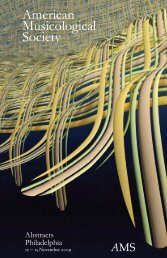Abstracts - American Musicological Society
Abstracts - American Musicological Society
Abstracts - American Musicological Society
You also want an ePaper? Increase the reach of your titles
YUMPU automatically turns print PDFs into web optimized ePapers that Google loves.
24 Thursday Afternoon: Session 1- 22<br />
AMS/SEM/SMT New Orleans 2012<br />
in-group identity and stereotyping the behavior of other groups, and ask what factors might precipitate such processes of social<br />
differentiation. I argue that, although pitched at the level of personal appearance, behavior, and “taste” the critiques deployed<br />
by these songs in fact point to more fundamental concerns: the opportunities for advancement that each group was perceived<br />
as possessing within the postwar economic order, and shifts in the new country’s class structure that have empowered certain<br />
groups economically and politically in unexpected ways.<br />
Balkan Beats DJs, and Club Culture: Producing Gypsy Music<br />
Carol Silverman (University of Oregon)<br />
In the 1990s, clubs in western Europe began to draw large crowds of young non-Roma to dance to remixed Balkan Gypsy<br />
music. This paper analyzes the production of this “Balkan Beats” soundscape by a growing DJ subculture, comprised of<br />
hundreds of performers on five continents. Based on fieldwork in western Europe and the US, I explore how DJs choose their<br />
materials and define “Balkan music” noting that 90% of their repertoire is Romani brass music; Balkan, Gypsy, and Brass are<br />
now interchangeable labels. Interrogating the issue of authenticity and the construction of the “fantasy Gypsy” my analysis<br />
highlights social, class, and ethnic differences among the various positionalities in this soundscape: the DJs, the clubbers,<br />
the marketers, and the Romani musicians whose music is sampled. DJs, clubbers, and marketers are mostly neither Roma<br />
nor from the Balkans. Balkan Beats promotes an acoustic style; non-Balkan DJs tend to shun amplified musics that feature<br />
synthesizers even though they are widespread in Romani communities; DJs from the Balkans, however, have a more eclectic<br />
repertoire. Some DJs are young and naïve about the Balkans and some do serious research. Some DJs remix for the love of it<br />
and make little money; on the other hand, a few are well paid. Roma, operating from a marginal class and social position, play<br />
an ambivalent role in this soundscape; they may be invisible or may provide “authenticity” through guest live performances or<br />
collaborations with DJs. Finally, marketers promote the music as a multicultural exchange that counteracts racism.<br />
Session 1-22 (SEM), 1:45–3:45<br />
Cultural Politics from the Top Down<br />
Donna Kwon (University of Kentucky), Chair<br />
Politics of “Arirang” : Tripartite Function of a Korean Folksong in the Republic of<br />
Korea, Democratic People’s Republic of Korea, and the People’s Republic of China<br />
Byong Won Lee (University of Hawai‘i)<br />
Arirang is the most well-known and popular folksong of Korea, which originated from the central region of Korea around<br />
the time of the Japanese annexation of Korea in 1910. It has evolved to be the iconic song for both South and North Korea.<br />
Recently, the Chinese government has designated Arirang as a cultural heritage of the Yanbian Korean Autonomous Region<br />
of China. South Korean conservatives are suspicious of the Chinese gesture as it is one of the ongoing Chinese appropriations<br />
of Korean heritage, which includes the ownership of some historical events. South Korean government is actively promoting<br />
the song internationally as a musical icon. On the other hand, the North Korean government hosts the “Arirang Festival” in<br />
honoring the birthday of the late “Dearest Leader of Kim Il-sung,” an effort to tone down the ideological stress through using<br />
a cultural title. This paper will explore the tripartite states of Arirang: as a musical icon through its nation-branding function<br />
in the Republic of Korea (South Korea), as a soft image-making medium in the Democratic People’s Republic of Korea (North<br />
Korea), and as a political embrace of minorities by the People’s Republic of China.<br />
Incorporated Ethnicity: Music, Tourism, and Cosmopolitanism in Northern Vietnam<br />
Lonán Ó Briain (University of Sheffield)<br />
Since the 1990s Sapa has transformed into what the Lonely Planet now calls “the destination of northwest Vietnam, [a]<br />
gateway to another world of mysterious minority cultures and luscious landscapes” (http://www.lonelyplanet.com/vietnam/<br />
northwest-vietnam/sapa). Staged performances of indigenous music and dance in Sapa focus on the culture of the resident<br />
ethnic minority groups, in particular the Hmong. In addition to informal street performances, the local authorities organize<br />
formal shows for tourists in the guise of cultural heritage preservation. This paper examines how the commodification of<br />
Hmong culture and the incorporation of Hmong identity are manifest in the most successful of these formal shows, the Cat<br />
Cat village show. The analysis, framed by the concept of Ethnicity, Inc. (Comaroff and Comaroff 2009), considers how local<br />
traditions are made palatable for a cosmopolitan tourist audience at the “contact zone” (Pratt 1992) of the performance. The<br />
calculated omission of certain vital aspects of the traditions, which are supposedly being preserved, demonstrates how these<br />
performances engender neoimperialist power relations where those with the money dictate the musical content, albeit indirectly.<br />
Furthermore, by representing Vietnamese-Hmong culture as tribal, exotic, or oriental the authorities are adopting a










